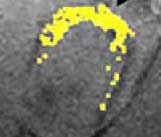Anyone facing chemotherapy would welcome an advance promising to dramatically reduce their dose of these often harsh drugs. Using nanotechnology, researchers at Washington University School of Medicine in St. Louis have taken a step closer to that goal.
The researchers focused a powerful drug directly on tumours in rabbits using drug-coated nanoparticles. They found that a drug dose 1,000 times lower than used previously for this purpose markedly slowed tumour growth.
'Many chemotherapeutic drugs have unwanted side effects, and we've shown that our nanoparticle technology has the potential to increase drug effectiveness and decrease drug dose to alleviate harmful side effects,' said Dr Patrick Winter, research assistant professor of medicine and biomedical engineering.
The nanoparticles are extremely tiny beads of an inert, oily compound that can be coated with a wide variety of active substances. Measuring around 200 nanometers across, their cores are composed mostly of perfluorocarbon, a safe compound used in artificial blood.
The researchers have already shown that they can significantly reduce tumour growth in rabbits that were treated with nanoparticles coated with a fungal toxin called fumagillin. Human clinical trials have shown that fumagillin can be an effective cancer treatment in combination with other anticancer drugs.
In addition to fumagillin, the nanoparticles' surfaces held molecules designed to stick to proteins found primarily on the cells of growing blood vessels. So the nanoparticles latched on to sites of blood vessel proliferation and released their fumagillin load into blood vessel cells. Fumagillin blocks multiplication of blood vessel cells, so it inhibited tumours from expanding their blood supply and slowed their growth.
Human trials have also shown that fumagillin can have neurotoxic side effects at the high doses required when given by standard methods. But the fumagillin nanoparticles were effective in very low doses because they concentrate where tumours create new blood vessels. The rabbits that received fumagillin nanoparticles showed no adverse side effects.
Dr Gregory Lanza, associate professor of medicine and of biomedical engineering, and Dr Samuel Wickline, professor of medicine, of physics and of biomedical engineering, are co-inventors of the nanoparticle technology.

A tumour treated with fumagillin nanoparticles (left) is smaller than an untreated tumour. Nanoparticles containing an image-enhancing metal (yellow) show that the treated tumour has much less blood vessel growth than the untreated tumour




April 1886: the Brunkebergs tunnel
First ever example of a ground source heat pump?